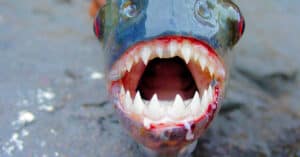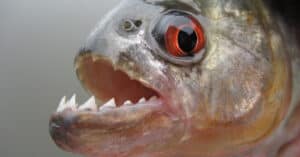If you’re not living under a rock, then you must have seen or at least heard about the infamous 1978 film, Piranha, and its 2010 remake, Piranha 3D. Piranhas, thanks to the very imaginative and innovative entertainment industry, and a little bit of help from Teddy Roosevelt, have garnered the reputation of killer fishes over the years. So, do piranhas need to be feared? In this article we’re digging into what piranhas eat and whether they’re dangerous to humans.
The Background on Piranhas

Piranhas have pointed razor-sharp teeth whereas the pacu has squarer, straighter teeth, that eerily resemble those of humans.
©Artex67/Shutterstock.com
Piranhas are one of the most frequent topics to pop up when talking about dangerous water animals, and that is next to sharks or killer whales. Once you hear their name, you might automatically picture piranhas as groups of fast-moving, sharp-toothed small fishes ready to devour any flesh, even those of humans, at any time.
However, these gruesome scenes from movies and other pop culture representations are highly unlikely to happen in real life. Piranhas don’t feed on living human flesh, and yes, they might bite when threatened, but they are usually not fatal.
Piranha, in the Tupi language of Brazil, means “tooth fish”. South American piranhas have razor-sharp teeth and a reputation for frenzied feeding. South American rivers and lakes are home to all piranhas, and the Amazon River is home to 20 different species. Piranhas have long been swimming under the spotlight for all the wrong reasons. In reality, they can be carnivorous or flesh-eaters, and can be herbivores as well. So, what do piranhas really eat underwater? Can they feed on larger animals?
What Do Piranhas Eat?
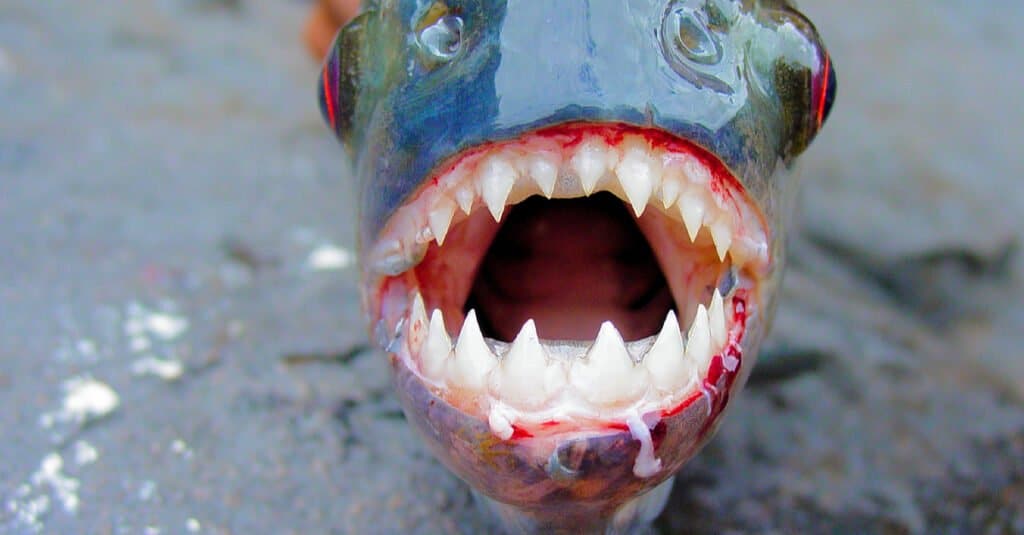
The teeth of an Amazon black piranha
©The Jungle Explorer/Shutterstock.com
Contrary to popular belief, piranhas do not dine on living, breathing people. Some piranhas are carnivorous, and some are omnivores, consuming more seeds and insects than mammals and other fish. The set of food piranhas typically like to eat in their diet includes:
- Insects
- Fish (especially smaller ones)
- Sea plants
- Crustaceans
- Mollusks
- Seeds
- Worms
- Birds
- Lizards
- Amphibians
- Reptiles
- Rodents
- Carrion
Since they feed on both land and water creatures at random, piranhas are sometimes referred to as “opportunistic carnivores” by biologists. In his visit to the Brazilian jungle, President Teddy Roosevelt revealed that he witnessed a piranha devouring a whole cow in a matter of minutes.
Because they enjoy the fins and tails of other aquatic animals, piranhas also show signs of cannibalism during times of low food supply. Piranhas have been known to eat their own kind when food is scarce and the competition for it is fierce. A protein mucus layer on fish scales provides a surprising amount of nutrition for wimple piranhas.
Despite their reputation of frenzied feeding, some piranhas feed more on seeds and plants rather than flesh, while some survive on plants alone, according to Smithsonian magazine. Tometes camunani, an Amazonian fish that only feeds on riverweeds, was discovered by scientists in Brazil’s Trombetas basin, in the Amazonian state of Pará. Their closest cousin, Colossoma macropomum, is also an omnivore, and eats mostly plant matter. Many fish markets sell Pacus as “vegetarian piranhas” and other derogatory names because they resemble some piranha species.
Are Piranhas Dangerous to Humans?
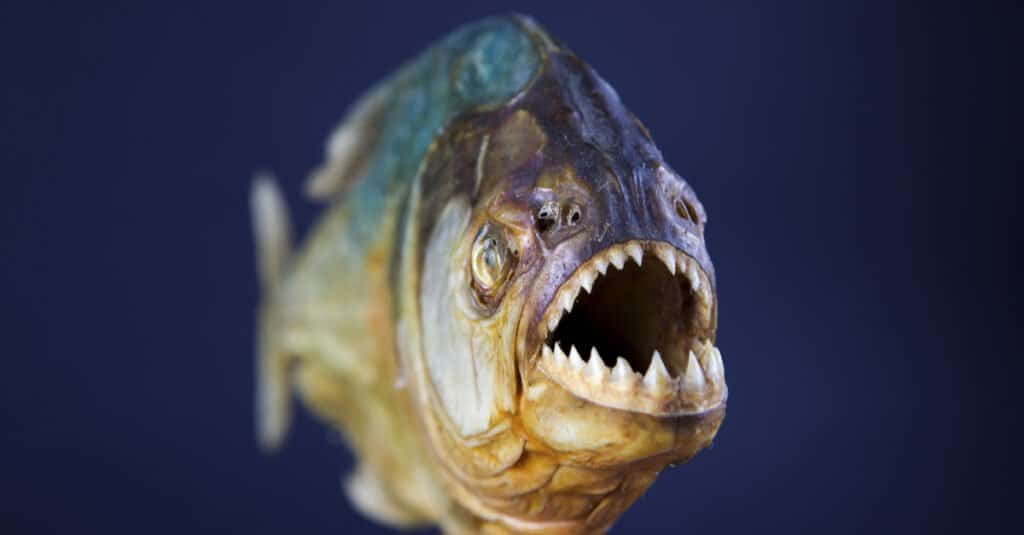
A close up of a piranha’s teeth
©simongee/Shutterstock.com
Are piranhas dangerous to humans? The answer is generally “no” as they avoid victims that would not be seriously injured. As you’ll read below, victims of piranha attacks were generally already deceased.
A piranha will not consider a human as food until it is certain that the victim has died or been seriously injured. However, this wild fish can bite swimmers when there is a lack of food or when their nests are vulnerable while they are laying eggs.
According to experts consulted by Popular Science, it would take between 300 and 500 piranhas to decapitate a 180-pound human in just five minutes. Although piranha nibbles have been found in the bodies of drowned heart attack and epilepsy victims in South American rivers, the victims were already dead when the piranhas got involved.
How Do Piranhas Hunt Down their Food?
Piranhas are known to hunt in packs. Just like in the movies, they do travel in groups, called schools or shoals. In most cases, a shoal consists of between 20 and 100 individuals, but this can vary greatly. Predators, such as crocodiles, birds, and mammals, are less likely to attack a group of fish swimming together.
When hunting for food, they are able to pick up on the scent and movement of people and other animals. They prey on simply anything that has caught the eye of a hungry shoal and cannot escape the water in time. Piranhas are also attracted to the splashing or irrational movements of a distressed animal. Other piranhas rush to the scene as soon as other animals start eating their prey. Moreover, according to an experiment conducted in 1972, red-bellied piranhas prefer to attack their prey’s tail and/or eyes first.
How Much Can a Piranha Eat in a Day?
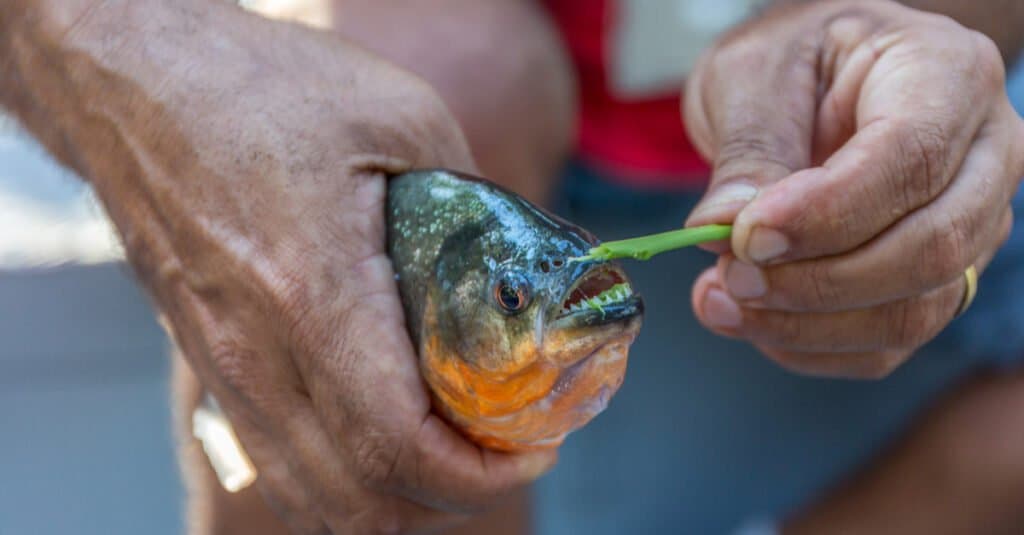
A red-bellied piranha
©Shawn Eastman Photography/Shutterstock.com
An adult piranha can eat about one-eight of its body mass. Red-bellied piranhas can grow up to 15 inches long and weigh up to 7 pounds with enough time, food, and space. They typically reach a height of 6-8 inches and a weight of 3 pounds. Just one red-bellied piranha, for instance, can feed itself around 2.46 grams per day.
What can piranhas eat in captivity or as pets?
Piranhas are able to eat a variety of foods, including live, frozen, dried, meaty, and vegetable-based ones. Piranhas will eat fish pellets and flakes, especially those that are rich in animal components, when they are kept in captivity. mealworms, earthworms, krill, and other feeder fishes can also be fed to them. While piranhas can eat any type of worm they come across in the wild, they can also eat the same worms in captivity without a problem.
It’s not uncommon for Piranhas in captivity to prefer frozen foods that have been defrosted. They can easily be poisoned by insects and worms that you find in your garden or yard, so if you are raising them in a controlled environment, make sure to be careful.
The photo featured at the top of this post is © The Jungle Explorer/Shutterstock.com
Thank you for reading! Have some feedback for us? Contact the AZ Animals editorial team.



